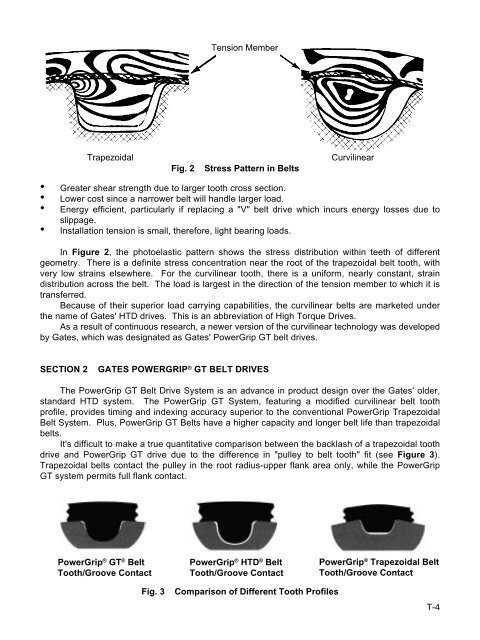THE WORLD OF TIMING BELTS - MAELabs UCSD
THE WORLD OF TIMING BELTS - MAELabs UCSD
THE WORLD OF TIMING BELTS - MAELabs UCSD
Create successful ePaper yourself
Turn your PDF publications into a flip-book with our unique Google optimized e-Paper software.
Trapezoidal<br />
Tension Member<br />
Fig. 2 Stress Pattern in Belts<br />
Curvilinear<br />
• Greater shear strength due to larger tooth cross section.<br />
• Lower cost since a narrower belt will handle larger load.<br />
• Energy efficient, particularly if replacing a "V" belt drive which incurs energy losses due to<br />
slippage.<br />
• Installation tension is small, therefore, light bearing loads.<br />
In Figure 2, the photoelastic pattern shows the stress distribution within teeth of different<br />
geometry. There is a definite stress concentration near the root of the trapezoidal belt tooth, with<br />
very low strains elsewhere. For the curvilinear tooth, there is a uniform, nearly constant, strain<br />
distribution across the belt. The load is largest in the direction of the tension member to which it is<br />
transferred.<br />
Because of their superior load carrying capabilities, the curvilinear belts are marketed under<br />
the name of Gates' HTD drives. This is an abbreviation of High Torque Drives.<br />
As a result of continuous research, a newer version of the curvilinear technology was developed<br />
by Gates, which was designated as Gates' PowerGrip GT belt drives.<br />
SECTION 2 GATES POWERGRIP ® GT BELT DRIVES<br />
The PowerGrip GT Belt Drive System is an advance in product design over the Gates' older,<br />
standard HTD system. The PowerGrip GT System, featuring a modified curvilinear belt tooth<br />
profile, provides timing and indexing accuracy superior to the conventional PowerGrip Trapezoidal<br />
Belt System. Plus, PowerGrip GT Belts have a higher capacity and longer belt life than trapezoidal<br />
belts.<br />
It's difficult to make a true quantitative comparison between the backlash of a trapezoidal tooth<br />
drive and PowerGrip GT drive due to the difference in "pulley to belt tooth" fit (see Figure 3).<br />
Trapezoidal belts contact the pulley in the root radius-upper flank area only, while the PowerGrip<br />
GT system permits full flank contact.<br />
PowerGrip ® GT ® Belt<br />
Tooth/Groove Contact<br />
PowerGrip ® HTD ® Belt<br />
Tooth/Groove Contact<br />
Fig. 3 Comparison of Different Tooth Profiles<br />
PowerGrip ® Trapezoidal Belt<br />
Tooth/Groove Contact<br />
T-4
















